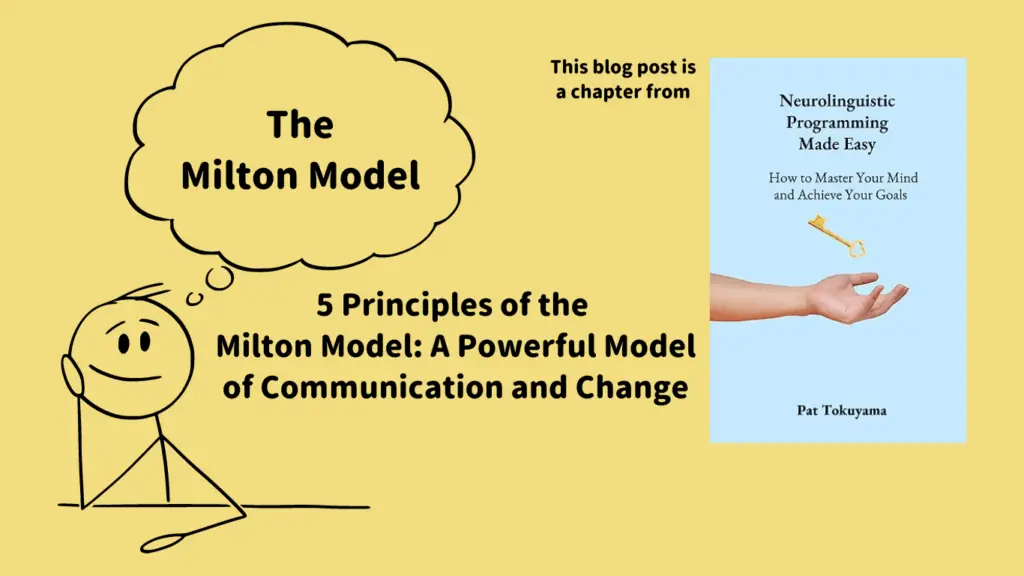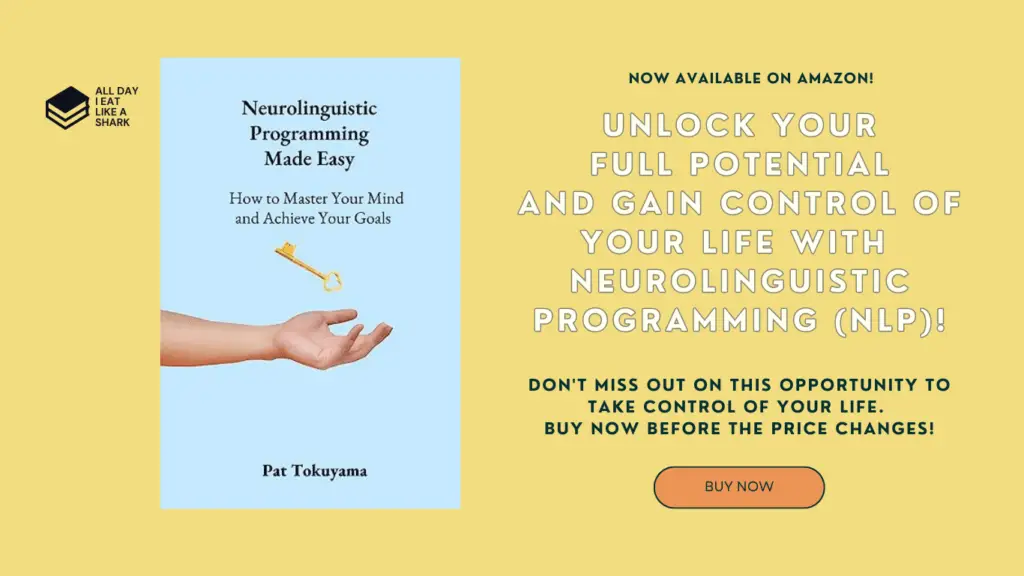
This is the second chapter of the Neurolinguistic Programming Made Easy: How to Master Your Mind and Achieve Your Goals by Pat Tokuyama
Guide to the Good Stuff
Imagine that you could use language to create positive change in yourself and others. Imagine that you could use words to access the hidden power of your unconscious mind, and to guide it towards your desired outcomes. Imagine that you could use stories and metaphors to captivate and influence your listeners, and to help them solve their problems and achieve their goals.
This is what the Milton Model can do for you.
What is the Milton Model?
The Milton Model, named after hypnotherapist Milton Erickson, is a set of language patterns employed to induce trance or an altered state of consciousness, aiding individuals in making desirable changes and solving complex problems. The model’s effectiveness is rooted in its ability to access the unconscious mind’s powerful resources, enabling profound shifts in perception and behavior. Metaphorically, the Milton Model can be described as a set of artfully vague suggestions that subtly guide the unconscious mind towards positive change.
The Milton Model is not just a collection of language patterns, but a coherent and powerful model of communication and change. It emphasizes indirect suggestion and the utilization of the client’s own frameworks and experiences. The model also has practical applications in various fields such as therapy, sales, leadership, and education.
The Milton Model is based on the following principles
1. The unconscious mind is a source of wisdom, creativity, and healing
The Milton Model aims to access and activate the unconscious mind’s resources, enabling profound shifts in perception and behavior.
2. The map is not the territory
The Milton Model recognizes that our internal representations are not accurate copies of reality, but rather subjective interpretations that are filtered, distorted, generalized, and deleted by our beliefs, values, memories, experiences, etc.
3. Resistance is a sign of a lack of rapport
The Milton Model avoids direct confrontation or challenge, and instead builds rapport by matching and pacing the client’s language, physiology, and state.
4. Utilization is the key to success
The Milton Model utilizes whatever the client brings to the session, such as their words, gestures, emotions, symptoms, metaphors, etc., and incorporates them into the therapeutic process.
5. Trance is a natural and everyday phenomenon
The Milton Model induces trance or an altered state of consciousness by using language patterns that engage the listener’s attention and imagination, creating a state of receptivity and responsiveness to suggestions.
In this chapter, you’ll learn:
- What are the language patterns of the Milton Model and how to use them in different contexts.
- What are the core principles of the Milton Model and how they relate to Ericksonian hypnotherapy
- What are the practical applications of the Milton Model in various fields such as therapy, sales, leadership, and education
- What are the potential implications of the Milton Model for personal development, communication, and influence
By the end of this chapter, you’ll be able to apply these techniques in various situations.
Language Patterns and Examples
The patterns used in the Milton Model are part of everyday language. However, the goal is not to memorize the names of these patterns, but to understand their nature, how they are used, and to create one’s own examples.
Several examples of Milton Model language patterns are provided below, which demonstrate their usage in different contexts.
1. Pacing current experience
This pattern helps you build rapport by describing what the listener can see, hear, or feel in the present moment. By matching and mirroring the listener’s sensory experience, you create a sense of connection and trust. You also help the listener focus their attention on the here and now, which can facilitate a trance state. For example:
- “As I am sitting here, in this chair, in my living room, typing this self-reflection, now.”
- “As you are reading this book, you may notice the words on the page, the sound of your breathing, the feeling of your body on the seat.”
- “As we are talking here, you can see my face, hear my voice, feel the air around us.”
2. Nominalization
This pattern helps you reduce resistance by turning a process or action into a thing or event. By doing this, you make the concept more abstract and less specific, which makes it harder for the listener to argue or disagree with it. You also make the concept more stable and permanent, which makes it more appealing and desirable. For example:
- “I am gaining more and more knowledge and learning.”
- “You have a lot of potential and talent.”
- “We have a strong relationship and trust.”
3. Tag question
This pattern helps you gain agreement by adding a question at the end of a statement. By doing this, you imply that the statement is true or obvious, and that the listener is expected to agree with it. You also create a subtle pressure for the listener to conform to your statement, as saying no would be rude or awkward. For example:
- “You’re enjoying this course, aren’t you?”
- “You want to improve your skills, don’t you?”
- “We have a common goal, don’t we?”
4. Lack of referential index
This pattern helps you create ambiguity by omitting specific details such as who, what, where, when, or how. By doing this, you involve the listener’s unconscious mind in filling the gaps with their own interpretations and associations. You also create a sense of curiosity and intrigue, as the listener wonders what you mean by your statement. For example:
- “The wonderful thing about this insightful training is that it enables my growth, and the ability to help myself …and do other things too.”
- “You can achieve anything you want if you have the right mindset …and some other things too.”
- “We can make a difference in this world if we work together …and some other things too.”
5. Mind reading
This pattern implies that you know what the listener is thinking or feeling, creating a sense of rapport and curiosity. For example:
- “You may be wondering how this works…”
- “You probably feel a bit skeptical about this…”
- “You already know what I’m going to say next…”
Mind reading statements send the person that you are communicating with into a mild form of confusion at the conscious level. They also bypass their critical faculty and appeal to their unconscious mind. Mind reading can be used to elicit or reinforce a state, to create curiosity, or to test a response.
6. Presupposition
This pattern embeds an assumption or implication in your statement, which the listener has to accept in order to process the statement. For example:
- Before you decide to buy this product, let me tell you about its features…”
- “When you start using this technique, you will notice a difference in your performance…”
- “If you were to imagine yourself succeeding, what would that look like?”
Presupposition statements are powerful because they can influence the listener’s beliefs, expectations, and behavior without being directly challenged or questioned. Presupposition can be used to create agreement, to set up an outcome, to suggest a possibility, or to induce trance.
Summary
As you can see, the Milton Model offers several effective methods to elicit change that can be applied in various situations. By using language patterns that induce trance and access the unconscious mind’s resources, one can achieve remarkable results in personal growth, problem solving and communication.
In the next chapter, you’ll learn about submodalities, the fine distinctions or qualities of your sensory experiences.
